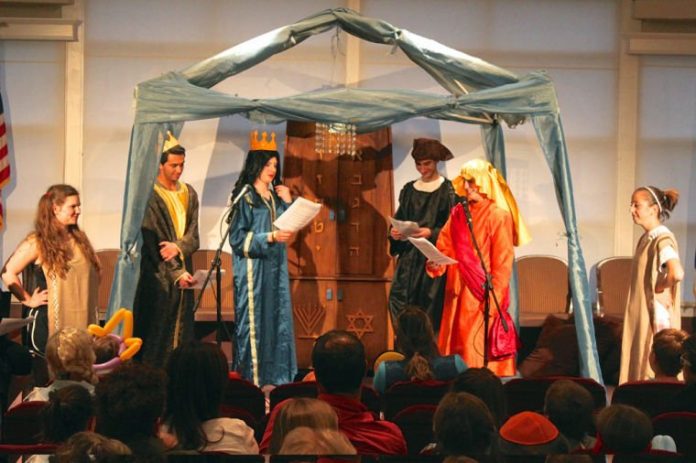
On March 14, members of Congregation Emeth (South Valley’s Jewish Community) celebrated a holiday quite unlike any other. Although Jewish holidays tend to be somewhat somber, Purim is marked by revelry and merry-making.
The story of this holiday comes from the Book of Esther (in what Christians call the Old Testament of the Bible). It commemorates the salvation of the Jewish people in ancient Persia.
Achashverosh was the King of Persia during the fifth century BCE. When his first wife displeases him by not coming when summoned, he chooses Esther to replace her – unaware that she is Jewish – and appoints Haman, a noted anti-Semite, as his prime minister.
Esther’s cousin and guardian is Mordechai, who earns Haman’s hatred by refusing to bow down to him. Because Mordechai is a Jew, Haman gets the King’s permission to not only kill him, but all the Jews in the realm. He then casts lot to choose the fateful date of extermination.
When Mordechai discovers this plot and convinces all the Jews to repent, fast and pray, he urges Esther to appeal to the King on behalf of her people to save them. This puts her in great danger because anyone who approaches the King without being summoned can be executed for this breach of royal etiquette.
Fortunately, Ahashverus is so pleased when she comes into his presence that he doesn’t punish her for barging in, instead granting her any request “even to the half of my kingdom.” Esther reveals that she is Jewish and asks for her people to be spared from the annihilation planned by Haman.
That decree can’t be withdrawn, but the king allows the Jews to arm and defend themselves, and they kill 500 attackers, including Haman’s 10 sons. In a final touch of irony, Haman is hanged on the very gallows which he had prepared for Mordechai to die on.
The bravery of Esther in risking her life to save her people is the origin of Purim (in Hebrew, “Lots” (referring to making a chance decision by using lots, such as straws or pebbles, etc.; in this story, “lots” refer to the method Haman used to select the date the Jews would be murdered). Congregation Emeth celebrated the holiday in traditional fashion.
First there was a gala carnival. Participants of all ages were encouraged to come in costume. Everyone enjoyed different booths offering games of skill and also games of chance (particularly appropriate for the theme of the day). Preceding services, there was a barbecue and a special dessert called “hamantashen” (fruit-filled pastries in the shape of three-cornered hats worn in the Persian court of that time).
After dinner, Shabbat services took place. During the services, the familiar story of Purim was read by Rabbi Debbie Israel from a scroll called the “Megillah.” While the events were being acted out by youth of the temple, the audience reacted boisterously. Each time the name of the hated Haman was proclaimed, it was drowned out by the loud, enthusiastic use of noisemakers called “groggers,” as well as booing and stamping of feet. Often the audience offered more approving noises such as cheers and clapping for other characters, much like during a traditional American melodrama.
The Book of Esther almost did not get included into the canon of the Hebrew Bible. Early rabbis didn’t think it had much religious significance – the name of “God” never even appears in the book. But Purim was loved by the Jewish people, and this forced Esther’s inclusion. Today Purim is enthusiastically celebrated around the world wherever Jews live because of its message of good winning over evil and the survival of Judaism.
Chuck Flagg is a retired teacher with a passion for religion. Reach him at cf****@**********rs.com.










